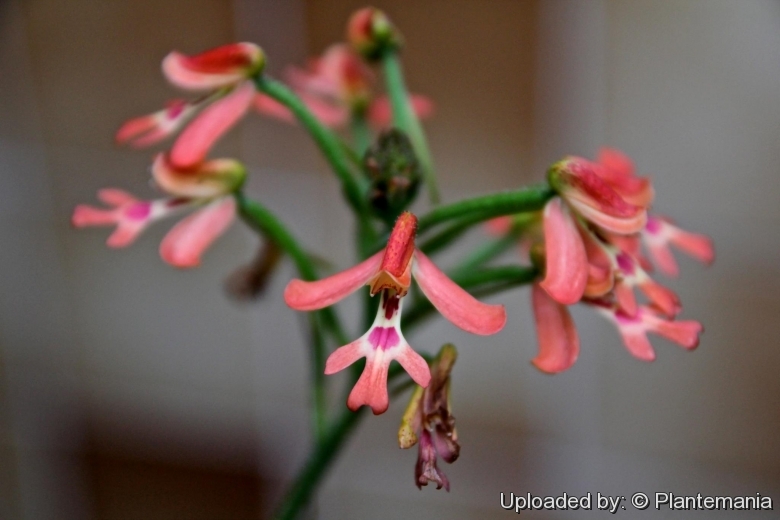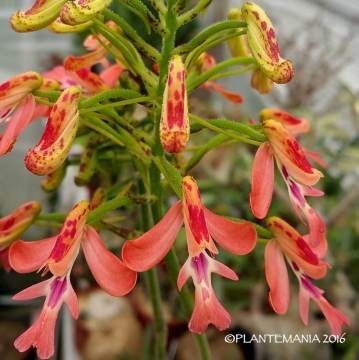
Cynorkis gibbosa Photo by: © Plantemania
Origin and Habitat: Cynorkis gibbosaSN|33370]]SN|33370]] is widespread in Madagascar where it grows in the provinces of Antananarivo, Antsiranana, Fianarantsoa, Toamasina and Toliara. Estimated area of occupancy (AOO) km2 225. There are 24 subpopulations of this species
Altitude range: 500 to 2500 metres above sea level.
Type locality: Trail from Antanifotsy to Pic Boby, high altitude meadow by mountain stream, 2000 metres.
Habitat and ecology: Open grassy country. It occurs in humid, subhumid and montane bioclimates. It is a lithophytic or terrestrial herb that grows in forest ecotones on shaded, wet rocks and on open but sheltered granite rock outcrops, generally on peaty or humus-rich soils in areas of seepage. C. gibbosa can occasionally be seen on the roadside and is not uncommon in the foothills of some of the mountain ranges. The main threats to this species are illicit collection and deforestation as a result of mining and wildfire.
Synonyms:
See all synonyms of Cynorkis gibbosa
back
Accepted name in llifle Database:Cynorkis gibbosa Ridl.J. Linn. Soc., Bot. 20: 331. 1883 [1884 publ. 1883]Synonymy: 2
back
Description: Cynorkis gibbosaSN|33370]]SN|33370]], often referred to as Cynosorchis, is a small to medium sized generally ground-growing (terrestrial) or lithophyte (growing on rocks) orchid 25-50 cm tall. Its flowers are salmon-pink or red, and about 25-35 mm in length and remarkable for their gibbous dorsal sepal (hence the name). They are numerous on spikes that are 30-50 cm tall. The leaves are beautiful, have characteristic darker patches and develop over a very short period, the plant flowers and the leaves then die back.
Tubers: Several elongated, villous.
Leaf: Solitary, oblong-lanceolate, up to 60 cm long with the young growths silver, grey-green with an overlay of mahogany spots.. The leaf that is shortly attenuate at both ends and amplexiculate basally.
Inflorescence: Bristly granular, sometimes glabrous.densely 10 to 40 flowered, subcorymbiform inflorescence carrying 2 to 3 distant, cauline sheaths and having 10 mostly simultaneous flowers at any one time.
Flowers: large, orange-red to raspberry red with a red mark at base of lip sepals 12-15 mm long; lip 3-lobed, up to 29 mm long; spur 2-2.5 cm long.
Blooming season: Mid spring through fall (in Madagscar August-May).
Subspecies, varieties, forms and cultivars of plants belonging to the Cynorkis gibbosa group
 Cynorkis gibbosa Photo by: © Plantemania
Cynorkis gibbosa Photo by: © PlantemaniaSend a photo of this plant.The gallery now contains thousands of pictures, however it is possible to do even more. We are, of course, seeking photos of species not yet shown in the gallery but not only that, we are also looking for better pictures than those already present.
Read More... Cultivation and Propagation: Cynorkis gibbosaSN|33370]]SN|33370]] is not difficult to grow and flower,in addition to its beauty, it's not common and a little fussy, meaning it's pretty easy while in growth but will die in days if you don’t respect it's resting period and back off on the water (but not completely bone dry – just the right amount). Water every 2-3 weeks in winter. When new growth emerges, water as mix approaches dryness. Not difficult to grow and flower! This plant does lose its leaves in winter with a tuber remaining in the pot.
Soil: Use a free draining medium.
Exposure: Best in filtered light, but the widely varying light levels don’t seem to bother them either, though they do seem happier in Phalaenopsis light.
Propagation: Seeds. As any typical orchid the Cynorkis have very fine, dust-like seeds but don’t seem to require any specialized fungus or other environmental factor to germinate and grow. Seedlings often grow on bark in pots with other orchids and in soil with normal greenhouse plants. Seedlings to bloom within 1 to 2 years.









